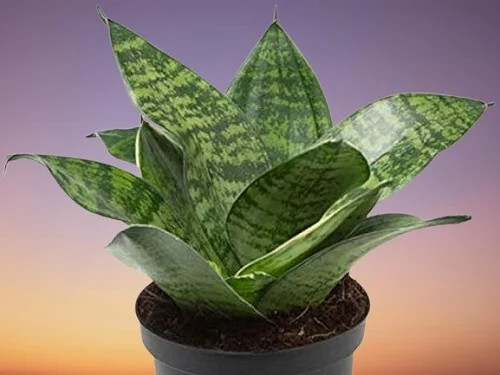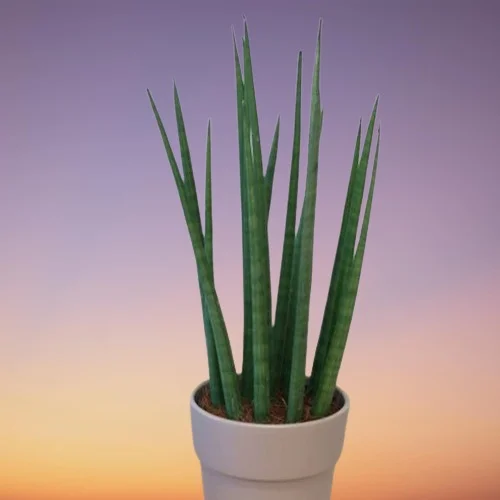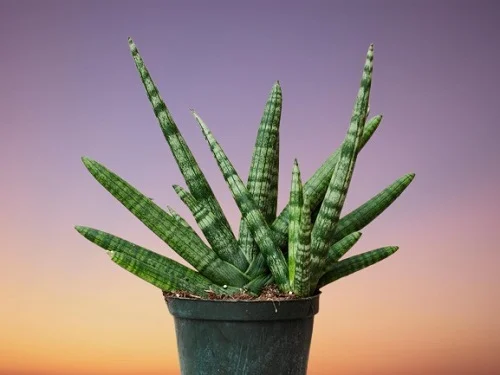19 Types of Snake Plants with Names and Pictures
Some links in this post may be affiliate links
Snake Plants are evergreen, flowering plants which were originally placed in the Sanseviera Genus but have recently been reclassified into the Dracaena Genus.
There are about 70 species of Snake Plants, largely native to Africa, Madagascar and southern Asia and go by the common names, Mother-in-law's Tongue, Devil's Tongue, Jinn's Tongue, Bow String Hemp, Snake Plant and Snake Tongue.
The leaves in Snake Plant species are typically arranged in a rosette around the growing point but in some species they are arranged in two-ranks.
Based on their leaves, Snake Plants can be categorised as hard-leaved or soft-leaved. Hard-leaved species have their origin in the arid climates while the soft-leaved species are native to the tropical and subtropical regions.

The hard-leaved species have several survival adaptations for the dry regions which include thick, succulent leaves for water storage and thick leaf cuticles to reduce loss of moisture.
The leaves in the hard-leaved species may also be cylindrical to reduce surface area, thus reduce water loss, and are usually shorter than those of the soft-leaved tropical species.
The flowers in Snake Plants are usually greenish-white but they can also be rose, lilac-red or brownish and are produced on a simple or branched raceme. They mature into a red or orange berry.
Snake Plants are popular plants on account of their amazing benefits in the home which include ease of care and ability to clean indoor air as they produce oxygen even at night among others.
This is because they carry out Crassulacean Acidic Metabolism (CAM) in which they harvest Carbon dioxide at night and use it during the day to make their food.
As they make their food, they store the oxygen they produce in the process and release it at night. This is an adaptation of these plants to their drought-prone climate which enables then survive the harsh climate.
Snake Plants (Sanseviera) grow best in bright light with 6-8 hours of direct sunshine, average warmth of 16-290C, humidity of 50-55% and moderately moist, loose, rich, succulents soil coupled with monthly feeding in spring and summer. Learn more on how to grow and care for Snake Plants (Sansevieria).
Unfortunately, Snake Plants are toxic to both humans and pets as indicated by ASPCA. They contain saponins which if ingested may cause nausea, vomiting and diarrhea. Keep these plants away from children and pets.
If you are looking to add Snake Plants to your collection, you may obtain these plants online from Amazon (Link to Amazon). We have outlined herebelow 19 varieties of Snake Plants from which you can make your selection.
19 Types of Sanseviera Varieties for the Home
Popular Snake Plant Varieties are Dracaena trifasciata, Dracaena trifasciata 'Laurentii', Dracaena trifasciata 'Hahnii', Dracaena trifasciata 'Golden Hahnii', Dracaena trifasciata 'Moonshine', Dracaena angolensis 'Boncel' among others.
1. Dracaena trifasciata

Dracaena trifasciata bears stiff, dark-green leaves with light gray-green cross-banding which grow vertically from a rosette and spreads by means of rhizomes.
The mature leaves are about 3-4 feet long and about 2.5 inches wide. Dracaena trifasciata can reach a height 6 ft in optimal conditions. It is native to to tropical West Africa from Nigeria east to Congo.
Dracaena trifasciata commonly called 'Mother-in-law's Tongue', 'Saint George's Sword' or 'Viper's Bowstring Hemp' is one of the commonest Snake Plants due to its ability to withstand harsh growing conditions.
2. Dracaena trifasciata 'Laurentii'

Dracaena trifasciata 'Laurentii' commonly called Variegated Snake Plant, Goldband Sansevieria or Variegated Mother-in-law's Tongue is a cultivar of Dracaena trifasciata whose leaves are edged in cream-yellow margins.
Variegated Snake Plant is best propagated by division of the mother plant as propagation by cuttings does not breed true to type; the variegation is lost and it reverts to the all-green form.
3. Dracaena trifasciata 'Hahnii'

Dracaena trifasciata 'Hahnii' commonly called Bird’s Nest Snake Plant or Dwarf Snake Plant is a low-growing (6-8 inches tall), rosette-like species which is ideal for the small spaces like a windowsill.
The leaves are dark-green with light gray-green cross-banding, spirally arranged, curved upwards along the edges and turning flat and recurving backwards as they mature.
4. Dracaena trifasciata 'Golden Hahnii'

Dracaena trifasciata 'Golden Hahnii' commonly called Golden Bird’s Nest Snake Plant is a variety of Dracaena trifasciata 'Hahnii' with dark-green, glossy leaves edged with broad, creamy-yellow margins.
Golden Bird’s Nest Snake Plant is a compact species which grows to aheight of about 6-8 inches making it perfect for the limited spaces like a table-top, desk, shelf, windowsill and others.
5. Dracaena angolensis

Dracaena angolensis formerly Sansevieria cylindrica and commonly called Cylindrical Snake Plant, African Spear, Spear Sansevieria or Saint Bárbara Sword is native to Angola, Africa.
Cylindrical Snake Plant bears striped, elongated, smooth, greenish-gray subcylindrical leaves in a fan-shaped rosette of stiff leaves.
The subcylindrical leaves are caused by a failure to express genes which cause the cylindrical bud to differentiate dorsoventrally. The flowers are greenish-white, tubular and tinged with pink.
6. Dracaena angolensis 'Boncel'

Dracaena angolensis 'Boncel' commonly called Starfish Snake Plant or Spear Orchid bears short, fat, round, light-green leaves with concentric circles down the entire length that grow in a fan-shape.
Starfish Snake Plant is a compact species which grows to a height of about 8 inches and spreads by means of rhizomes to form a mat making ideal for a groundcover and for small spaces.
7. Dracaena masoniana

Dracaena masoniana commonly called 'Whale Fin Snake Plant' or 'Shark's Fin Snake Plant' and initially called 'Mason Congo' is native to the Democratic Republic of Congo.
Whale Fin Snake Plant bears large, striking, dark-green leaves with lighter-green cross-banding along the leaf length.
8. Dracaena masoniana 'Variegata'

Dracaena masoniana 'Variegata' commonly called 'Variegated Whale Fin Snake Plant' or 'Variegated Shark's Fin Snake Plant' is a cultivar of Dracaena masoniana whose leaves are edged with cream-yellow margins.
9. Dracaena zeylanica

Dracaena zeylanica commonly called Ceylon Bowstring Hemp bears olive-green leaves with pale green wavy-like horizontal stripes.
Ceylon Bowstring Hemp looks like Dracaena trifasciata but Ceylon Bowstring Hemp has slightly more erect but shorter leaves and grows to a height of 2-3 feet and about 1 foot wide.
10. Dracaena trifasciata 'Moonshine'

Dracaena trifasciata 'Moonshine' commonly called Moonshine Snake Plant or Moonlight Snake Plant bears broad, succulent, pale, silvery-green, spear-shaped leaves with dark green margins.
Moonshine Snake Plant grows to a height of 2 feet and requires bright indirect light as in low light conditions, the leaves may turn a darker green.
The flowers in Moonlight Snake Plant are white, inconspicuous, and slightly scented but the plant may not bloom when grown indoors.
11. Dracaena hanningtonii 'Samurai Dwarf'

Dracaena hanningtonii 'Samurai Dwarf' or Dracaena ehrenbergii ‘Samurai Dwarf’ is a slow growing succulent plant which bears leaves in two opposite rows to form a fan-shape.
Dracaena ehrenbergii ‘Samurai Dwarf’ is a low-growing plant which grows to a height of about 1/2 foot only. The leaves are dark-green, edged in brownish-red and grooved on the inner side.
12. Dracaena eilensis

Dracaena eilensis formerly Sanseviera eilensis is a succulent plant with rough, cylindrical, downward curving leaves which grow from the underground rhizome.
The leaves are light bluish-green with bands of white and are marked by green longitudinal lines which mark the areas at which the leaf will fold in on itself during drought or swell on being watered.
The leaves in young plants have a deep channel, which runs the full length of the leaf and has reddish-brown margins edged with a papery brown cuticle.
As the plant ages, the edges of the new leaves roll together to form a smooth cylindrical leaf with a dried papery cuticle at the tip and base of the leaf.
13. Dracaena trifasciata 'Bentel's Sensation

Dracaena trifasciata 'Bentel's Sensation' features dark, grey-green, upright leaves with contrasting creamy white stripes.
Bentel's Sensation Snake Plant grows slowly to form colonies about 2 feet wide. The leaves can grow to a height of 3 feet tall and about 1 inch wide.
The flowers in Bentel's Sensation Snake Plant are creamy white, tubular and slightly fragrant and are held on a tall, upright inflorescence.
14. Dracaena ballyi

Dracaena ballyi grows in small rosettes with leaves that have bands of color and sharp tips and have grooves from the base to around 3/4 of the length.
This native of Eastern Africa in Kenya and Tanzania bears white, bottle-shaped flower spikes in clusters.
Dracaena ballyi is a dwarf snake plant which grows to a height of about 6 inches and it gets its species name from the Swiss botanist Dr. Peter Bally.
15. Sanseviera trifasciata 'Black Dragon'

Sanseviera trifasciata 'Black Dragon' also called Sanseviera trifasciata ‘Future Midnight’ is a spectacular, rare variety with thick, dark green leaves which grow in a rosette.
Black Dragon is a product of cuttings propagated from Sanseviera trifasciata 'Sheri' which is a variegated plant but the cuttings do not breed true to type as the variegation is often lost.
16. Sanseviera Cleopatra

Sanseviera Cleopatra or Cleopatra Snake Plant is a stemless, perennial, succulent plant with thick, silvery blue-green, striped leaves whose leaf margin is wavy and reddish brown.
Cleopatra Snake Plant is a charming, low-growing plant whose leaves are flattened and growing in a rosette which makes it perfect for a table-top, desk-top and other small spaces.
17. Sanseviera trifasciata 'Whitney'

Sanseviera trifasciata 'Whitney' commonly called Silver Flame Snake Plant bears silvery-green, stiff, upright leaves which are marked by rich, dark green horizontal stripes along the edges.
Silver Flame Snake Plant is a striking compact plant which can grow to a height of 1.5-2 feet making it ideal for limited spaces in the home.
18. Dracaena bacularis 'Mikado'

Dracaena bacularis 'Mikado' bears dense, evergreen foliage of thin green leaves with pale-green horizontal bands which have vertical grooves from the base to the tip.
Dracaena Mikado is a spectacular plant whose leaves grow straight out of the ground and looks spectacular on a table-top.
19. Sanseviera Silver Blue

Sanseviera Silver Blue is a stemless, succulent plant which bears silver-blue foliage patterned with darker longitudinal lines and mottling whose leaf color is more pronounced in bright light.
The flower in Sanseviera Silver Blue are greenish-white with green on the back and tips while the rest is brownish-pink and they are scented.
Sanseviera Silver Blue is thought to be a cultivar of Sanseviera kirkii also called Dracaena pethera which has its origins in Tanzania, Zanzibar and Malawi.
Frequently Asked Questions
1. What is the best variety of Snake Plant?
The best and most common variety of Snake Plant is Dracaena trifasciata which comes in several varieties like Dracaena trifasciata 'Laurentii', Dracaena trifasciata 'Hahnii', Dracaena trifasciata 'Golden Hahnii', Dracaena trifasciata 'Moonshine' among others.
2. What are the disadvantages of Snake Plants?
The main disadvantages of Snake Plant are susceptibility to overwatering and soggy soil, being toxic to both humans and pets, sensitivity to amounts of light and difficulty in bringing it to flower.
3. What are the benefits of Snake Plants?
Snake Plants are beneficial in that they clean the air and increase oxygen concentrations. They are also low maintenance and easy to grow even for a beginner. In addition they are beautiful plants which come in many shapes and colors.
4. Can you place a Snake Plant in the bedroom?
Yes. Snake Plants are some of the best plants for the bedroom. Due to their air cleaning properties and ability to produce large amounts of oxygen at night, they promote good sleep and relaxation.
5. What is the weakness of Snake Plant?
The greatest weakness of Snake Plants is their inability to tolerate overwatering and soggy soil which result in root-rot and death of the plant. The second weakness of Snake Plants is too little light. Though they can withstand lower amounts of light for some time, they will eventually die if allowed to grow in such conditions for a prolonged period.
6. Is Snake Plant poisonous?
Yes. Snake Plants are toxic to both humans and pet due to the presence of saponins as indicated by ASPCA. If ingested they may cause nausea, vomiting and diarrhea.
7. How do you encourage new growth on a Snake Plant?
To encourage new growth on a Snake Plant, make sure to give it the right growing conditions. Snake Plants do best in very bright light with at least 6-8 hours of direct sunshine, average warmth of 16-290C and moderately moist, loose, rich, succulents soil coupled with monthly feeding during the growing season.
8. What is the secret of Snake Plant?
The secret of Snake Plant is its air cleaning properties as it removes formaldehyde, benzene, xylene, toulene and trichloroethylene. Being a CAM (Crassulacean Acidic Metabolism) plant, it also produces high amounts of oxygen at night.
9. Why is my Snake Plant alive but not growing?
One of the reasons why your Snake Plant is alive but not growing is too little light. Ensure that your plant is receiving bright light with at least 6-8 hours of direct sunlight or grow the plant under a grow light.
The second reason your Snake Plant is alive but not growing is underwatering. Keep the soil moderately moist during the growing season and slightly moist in the cold period but do not allow the soil to dry out completely.
The third reason why your Snake Plant is alive but not growing is exposure to cold drafts. Keep the plant away from windy doors and windows, ventilators and other drafty conditions to maintain average warmth of 16-290C.
10. How do you revive a dying Snake Plant?
A Snake Plant may die due to soggy soil and or inadequate light. If death is due to too little light, move the plant infront of a brightly-lit window where it will receive very bright light or invest in a grow light if the natural light is not adequate.
Where death of the plant is due to soggy soil, take out the plant from its pot and inspect the roots. Cut off the affected moldy, mushy roots. Cut away any damaged leaves at the base.
Treat the healthy roots with a fungicidal solution and repot the plant in fresh potting soil and a fresh pot. Position the repotted plant in a well-lit, warm (16-290C) place and maintain the soil on the dry for about 7 days before you can resume watering.


